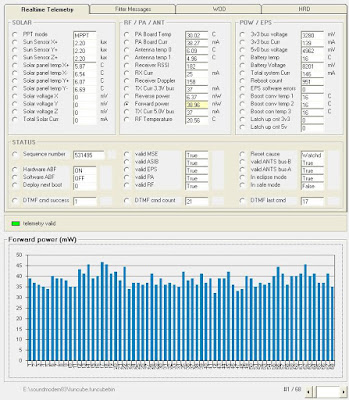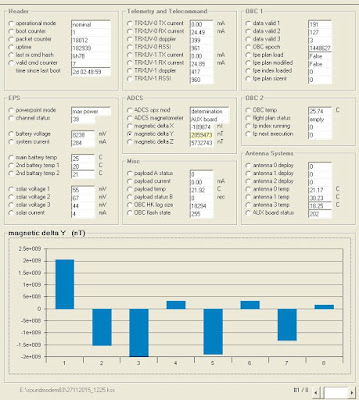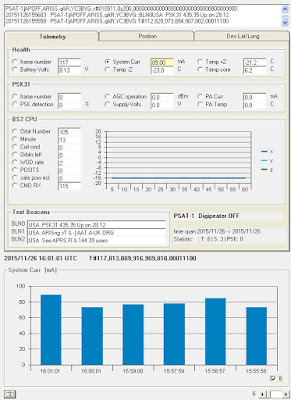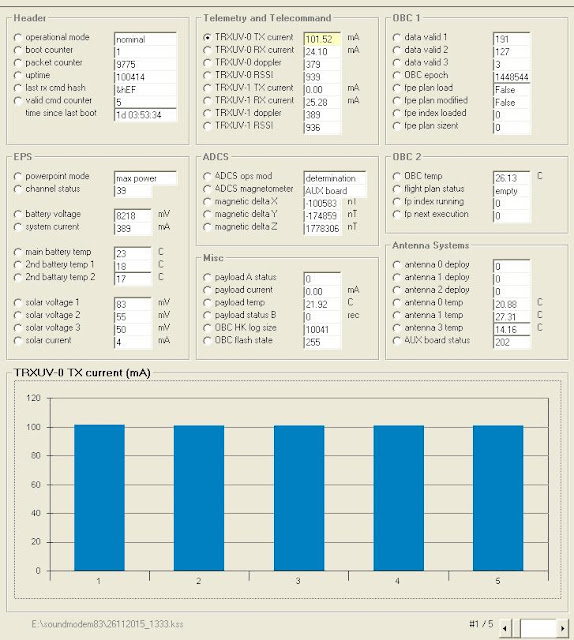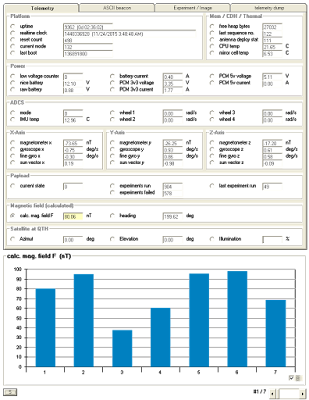
Home » Archives for November 2015
PSAT

20151128152337 : PSAT-1]APOFF,ARISS,qAR,YC3BVG:s#012464,0z200,000000000000000000000000000000000000
20151128152310 : PSAT-1]APOFF,ARISS,qAR,YC3BVG:T#917,809,070,908,900,800,00011100
20151128152209 : PSAT-1]APOFF,ARISS,qAR,YC3BVG:T#916,811,070,904,901,798,00011100
20151128152110 : PSAT-1]APOFF,ARISS,qAR,YC3BVG:T#915,812,069,900,900,797,00011100
20151128152026 : PSAT-1]APOFF,ARISS,qAR,YC3BVG:s#012462,0z200,000000000000000000000000000000000000
20151128152009 : PSAT-1]APOFF,ARISS,qAR,YC3BVG:T#914,813,070,896,899,795,00011100
20151128151909 : PSAT-1]APOFF,ARISS,qAR,YC3BVG:T#913,813,070,890,898,794,00011100
20151128151851 : PSAT-1]APOFF,ARISS,qAR,YC3BVG:s#012461,0z200,000000000000000000000000000000000000
20151128151713 : PSAT-1]APOFF,ARISS,qAR,YD0NXX-4:s#012460,0z200,000000000000000000000000000000000000
SHINEN 2 (SHIN-EN 2) reaches its closest point to the earth on December 4, 2015.
…
【To ham operators】
In SHIN-EN 2, the radiation sensor which Prairie View A&M University and NASA developed was equipped with.In the signals of C line, these observation data are included.
Because these reception data are very valuable scientifically, please report the data to us.
Professor of the Kyushu Institute of Technology, Graduate school of Engineering, Kei-ichi OKUYAMA: okuyama@ise.kyutech.ac.jp
Professor of the Aichi University of the Technology, Graduate school of Engineering, Masanori NIHIO: nishio-masanori@aut.ac.jp
Please report it to Prof. FUKUSHIMA about your situation of the reception
Professor of Kagoshima University, Graduate school of Engineering, Seiji FUKUSHIMA: jh6rto@m.ieice.org
★ Telemetry Line (C Line)
Frequency, Link Design
Downlink (Shin-en2 -> Ground)
(1) Down-link: 437.385MHz
(2) Up-link: Closed.
SHIN-EN 2 was equipped with a radiation sensor which Prairie View A&M University and NASA developed.
In the signal of the telemetry line (C Line), measured data are included.
This is very important scientifically.
If you succeeded in the reception, please send us the data.
We will send something present about SHIN-EN 2 to you.
Professor of the Kyushu Institute of Technology, Graduate school of Engineering, Kei-ichi OKUYAMA: okuyama@ise.kyutech.ac.jp
Professor of the Aichi University of the Technology, Graduate school of Engineering, Masanori NIHIO: nishio-masanori@aut.ac.jp
★ Transponder Line (A Line) This line will be occupied ham operators.
Frequency, Link Design
Downlink (Shin-en2 -> Ground)
(1) Down-link: Designated frequency 435.270MHz (435.280-435.260MHz)
(2) Up-link : Designated frequency 145.950MHz (145.940–145.960MHz)
★ Beacon Line (B Line)
Frequency, Link Design
Downlink (Shin-en2 -> Ground)
A call sign of SHINEN2: JG6YIG
(1) Down-link: 437.505MHz
(2) Up-link: None
These are specifications when SHIN-EN 2 reaches its closest point to the earth.
Distance of the closest approach: 5,715,777 km
The date and time of the closest approach: December 4, 2015, 10:27(GMT)
Relations with the distance from the earth and the day when passed after launching.
Declination, Right Ascension, Elevation and Azimuth at the Kyushu Institute of Technology and Houston.
To the ham operator who wants to try the signal reception.
Please send your E-mail to Prof. OKUYAMA.
We will send a detailed calculation result about Declination, Right Ascension, Elevation and Azimuth of your area to you.
Professor of the Kyushu Institute of Technology, Graduate school of Engineering, Kei-ichi OKUYAMA: okuyama@ise.kyutech.ac.jp
...
[Information of the signal which ham operators received in the past]
.
[December 9, 2014]
Telemetry Line, C system
Reception time: 5:54 (JST)
Approximate position of Shinen2: 2,310,000 km from the erath
[December 8, 2014]
Telemetry Line, C system
Reception time: 00:00 (JST)
Reception place: Latitude 52.3 degrees, Longitude 5.5 degrees
Approximate position of Shinen2: 1,894,000 km from the erath
[December 7,2014]
Telemetry Line, C system
Reception time: 06:27 (JST)
Reception place: Latitude 52.3 degrees, Longitude 21.0 degrees
Approximate position of Shinen2: 1,510,000 km from the erath
[December 7,2014]
Telemetry Line, C system
Reception time: 0:00 (JST)
Reception place: Latitude 34.0 degrees, Longitude 131.8 degrees
Approximate position of Shinen2: 1,450,000 km from the erath
[December 5,2014]
Telemetry Line, C system
Reception time: 09:00 (JST)
Approximate position of Shinen2: 770,000 km from the erath
.
[December 4,2014]
Telemetry Line, C system
Reception time: 21:11
Reception place: Latitude 35.4 degrees, Longitude 139.6 degrees
Elevation angle: 17 degrees
Azimuth angle: 148 degrees
Reception frequency: 437.3380 MHz
Approximate position of Shinen2: 530,000 km from the erath
[December 3,2014][December 4,2014]
Telemetry Line, C system
Reception time: 21:11
Reception place: Latitude 35.4 degrees, Longitude 139.6 degrees
Elevation angle: 17 degrees
Azimuth angle: 148 degrees
Reception frequency: 437.3380 MHz
Approximate position of Shinen2: 530,000 km from the erath
Telemetry Line, C system
Reception time: From 23:45
Reception place: Latitude 34.83 degrees, Longitude 137.19 degrees
Elevation angle: 24.7 degrees
Azimuth : 137.19 degrees
Reception frequency: 437.3776MHz
Approximate position of Shinen2: 200,000km from the earth
.
【December 9, 2014】 (Kita-Kyusyu)
Observation start: 19:21 (azimuth 125.8 degrees, elevation angle 0.0 degrees)
The biggest attack angle: 23:52 (azimuth declination 180.0 degrees, elevation angle 27.0 degrees)
Observation end: 04:23 (azimuth declination 234.2 degrees, elevation angle 0.0 degrees)
.
【December 8, 2014】 (Kita-Kyusyu)
Observation start: 19:25 (azimuth 125.9 degrees, elevation angle 0.0 degrees)
The biggest attack angle: 23:55 (azimuth declination 179.8 degrees, elevation angle 26.9 degrees)
Observation end: 04:26 (azimuth declination 234.0 degrees, elevation angle 0.1 degrees)
.
【December 7, 2014】 (Kita-Kyusyu)
Observation start: 19:29 (azimuth 126.0 degrees, elevation angle 0.0 degrees)
The biggest attack angle: 00:00 (azimuth declination 180.4 degrees, elevation angle 26.9 degrees)
Observation end: 04:29 (azimuth declination 233.9 degrees, elevation angle 0.2 degrees)
.
【December 6, 2014】 (Kita-Kyusyu)
Observation start: 19:32 (azimuth 126.1 degrees, elevation angle 0.0 degrees)
The biggest attack angle: 00:02 (azimuth declination 180.0 degrees, elevation angle 26.8 degrees)
Observation end: 04:32 (azimuth declination 233.9 degrees, elevation angle 0.1 degrees)
.
【December 5, 2014】 (Kita-Kyusyu)
Observation start: 19:35 (azimuth 126.1 degrees, elevation angle 0.0 degrees)
The biggest attack angle: 00:05 (azimuth declination 180.1 degrees, elevation angle 26.7 degrees)
Observation end: 04:34 (azimuth declination 233.8 degrees, elevation angle 0.1 degrees)
【December 4, 2014】 (Kita-Kyusyu)
Observation start: 19:37 (azimuth 126.3 degrees, elevation angle 0.0 degrees)
The biggest attack angle: 00:10 (azimuth declination 181.3 degrees, elevation angle 26.6 degrees)
Observation end: 04:35 (azimuth declination 233.8 degrees, elevation angle 0.0 degrees)
【December 3, 2014】 (Kita-Kyusyu)
Observation start: 19:22(declination -27.7 degrees, right ascension 28.0 degrees, attack angle 4.7 degrees)
The biggest attack angle: 23:19 (declination -28.4 degrees, right ascension 23.7, degrees attack angle 23.9 degrees)
Observation end: 03:41 (declination -28.7 degrees, right ascension 21.8 degrees, attack angle 0.1 degrees)
.
Orbit information of Shinen2
..
.
Launching date: Monday, December 3, 2014
Launching planned time: 13:22:04 (Japan Standard Time)
Separation of SHINEN2: 15:16:06 (Japan Standard Time)
Launching planned time: 13:22:04 (Japan Standard Time)
Separation of SHINEN2: 15:16:06 (Japan Standard Time)
SOURCE : http://kit-okuyama-lab.com/en/
PSAT-1 TELEMETRY

PSAT-1 TELEMETRY
20151126160101 : PSAT-1]APOFF,ARISS,qAR,YC3BVG:T#117,813,089,916,909,810,00011100
20151126160048 : PSAT-1]APOFF,ARISS,qAR,YC3BVG::BLN2USA :See APRS.FI & 144.39 users
20151126160004 : PSAT-1]APOFF,ARISS,qAR,YC3BVG:s#010513,0z200,000000000000000000000000000000000000
20151126160001 : PSAT-1]APOFF,ARISS,qAR,YC3BVG:T#116,815,073,912,910,808,00011100
20151126155913 : PSAT-1]APOFF,ARISS,qAR,YC3BVG::BLN0USA :PSK31 435.35 Up on 28.12
20151126155900 : PSAT-1]APOFF,ARISS,qAR,YC3BVG:T#115,816,077,908,910,807,00011100
20151126155828 : PSAT-1]APOFF,ARISS,qAR,YC3BVG:s#010512,0z200,000000000000000000000000000000000000
20151126155759 : PSAT-1]APOFF,ARISS,qAR,YC3BVG:T#114,817,078,903,910,805,00011100
20151126155738 : PSAT-1]APOFF,ARISS,qAR,YC3BVG::BLN1USA :ARISng sT & -] AAT.A-UK ORG
20151126155657 : PSAT-1]APOFF,ARISS,qAR,YC3BVG:T#113,818,085,898,908,804,00011100
20151126155653 : PSAT-1]APOFF,ARISS,qAR,YC3BVG:s#010511,0z200,000000000000000000000000000000000000
20151126155603 : PSAT-1]APOFF,ARISS,qAR,YC3BVG::BLN0USA :PSK31 435.35 Up on 28.12
20151126155558 : PSAT-1]APOFF,ARISS,qAR,YC3BVG:T#112,820,073,894,907,802,00011100
20151126160048 : PSAT-1]APOFF,ARISS,qAR,YC3BVG::BLN2USA :See APRS.FI & 144.39 users
20151126160004 : PSAT-1]APOFF,ARISS,qAR,YC3BVG:s#010513,0z200,000000000000000000000000000000000000
20151126160001 : PSAT-1]APOFF,ARISS,qAR,YC3BVG:T#116,815,073,912,910,808,00011100
20151126155913 : PSAT-1]APOFF,ARISS,qAR,YC3BVG::BLN0USA :PSK31 435.35 Up on 28.12
20151126155900 : PSAT-1]APOFF,ARISS,qAR,YC3BVG:T#115,816,077,908,910,807,00011100
20151126155828 : PSAT-1]APOFF,ARISS,qAR,YC3BVG:s#010512,0z200,000000000000000000000000000000000000
20151126155759 : PSAT-1]APOFF,ARISS,qAR,YC3BVG:T#114,817,078,903,910,805,00011100
20151126155738 : PSAT-1]APOFF,ARISS,qAR,YC3BVG::BLN1USA :ARISng sT & -] AAT.A-UK ORG
20151126155657 : PSAT-1]APOFF,ARISS,qAR,YC3BVG:T#113,818,085,898,908,804,00011100
20151126155653 : PSAT-1]APOFF,ARISS,qAR,YC3BVG:s#010511,0z200,000000000000000000000000000000000000
20151126155603 : PSAT-1]APOFF,ARISS,qAR,YC3BVG::BLN0USA :PSK31 435.35 Up on 28.12
20151126155558 : PSAT-1]APOFF,ARISS,qAR,YC3BVG:T#112,820,073,894,907,802,00011100
NOAA-18

Satellite: NOAA 18
Pass Start: 26 Nov 2015 08:55:01 GMT
Pass Duration: 14:02
Elevation: 22
Azimuth: 79
Solar Elevation: 10.4
Direction: northbound
Creation Time: 26 Nov 2015 08:56:23 GMT
Satellite Type: NOAA
Channel A: 1 (visible)
Channel B: 4 (thermal infrared)
Enhancement: MCIR
Ground Station: YC3BVG, indonesia
NOAA-19

Satellite: NOAA 19
Pass Start: 25 Nov 2015 07:11:12 GMT
Pass Duration: 15:17
Elevation: 44
Azimuth: 256
Solar Elevation: 54.3
Direction: northbound
Creation Time: 25 Nov 2015 07:12:29 GMT
Satellite Type: NOAA
Channel A: 2 (near infrared)
Channel B: 4 (thermal infrared)
Enhancement: msa
Ground Station: YC3BVG, indonesia
PSAT

20151124163756 : PSAT-1]APOFF,ARISS,qAR,YC3BVG:s#008611,0z200,00000000A00A00000000A00A00000000000A
20151124163624 : PSAT-1]APOFF,ARISS,qAR,YC3BVG:s#008610,0z200,00A00A00000000000A00A00000000A00A000
20151124163447 : PSAT-1]APOFF,ARISS,qAR,YC3BVG:s#008609,0z200,00000000000A00A00000000A00A000000000
20151124163444 : PSAT-1]APOFF,ARISS,qAR,YC3BVG:T#313,812,073,952,880,805,00011100
20151124163343 : PSAT-1]APOFF,ARISS,qAR,YC3BVG:T#312,813,073,951,877,804,00011100
20151124163312 : PSAT-1]APOFF,ARISS,qAR,E27CBR-6:s#008608,0z200,00000A00A00000000A00A00A00000000A00A
20151124163242 : PSAT-1]APOFF,ARISS,qAR,YC3BVG:T#311,814,073,950,874,802,00011100
20151124163138 : PSAT-1]APOFF,ARISS,qAR,YC3BVG:s#008607,0z200,00A00A00000A00A00A00000000A00A00A000
PCSAT
20151123225742 : PCSAT-11]BEACON,SGATE,qAR,W0BSP-10:T#001,106,070,068,076,219,11111111,0000,1
20151123225642 : W3ADO-1]BEACON,SGATE,qAR,W7TKO-1:T#002,129,132,133,133,215,11111111,0001,1
20151123225542 : W3ADO-1]BEACON,SGATE,qAR,WB9COY-1:T#001,054,127,067,039,215,11111111,0000,1
20151123211927 : W3ADO-1]BEACON,SGATE,qAR,KF5TJR:T#002,129,132,133,133,215,11111111,0001,1
20151123211828 : W3ADO-1]BEACON,SGATE,qAR,KF5TJR:T#001,031,089,064,085,215,11111111,0000,1
20151123211526 : W3ADO-1]BEACON,SGATE,qAR,KF5TJR:T#004,158,158,040,209,215,11111111,0011,1
20151123211425 : PCSAT-11]BEACON,SGATE,qAR,VA3APW:T#001,105,070,068,078,219,11111111,0000,1
20151123203327 : W3ADO-1]BEACON,SGATE,qAR,YC3BVG:T#004,156,157,042,209,215,11111111,0011,1
20151123203225 : PCSAT-11]BEACON,SGATE,qAR,9W2JDY-1:T#001,105,070,116,077,219,11111111,0000,1
20151123203127 : W3ADO-1]BEACON,SGATE,qAR,YC3BVG:T#002,132,133,135,146,215,11111111,0001,1
20151123225642 : W3ADO-1]BEACON,SGATE,qAR,W7TKO-1:T#002,129,132,133,133,215,11111111,0001,1
20151123225542 : W3ADO-1]BEACON,SGATE,qAR,WB9COY-1:T#001,054,127,067,039,215,11111111,0000,1
20151123211927 : W3ADO-1]BEACON,SGATE,qAR,KF5TJR:T#002,129,132,133,133,215,11111111,0001,1
20151123211828 : W3ADO-1]BEACON,SGATE,qAR,KF5TJR:T#001,031,089,064,085,215,11111111,0000,1
20151123211526 : W3ADO-1]BEACON,SGATE,qAR,KF5TJR:T#004,158,158,040,209,215,11111111,0011,1
20151123211425 : PCSAT-11]BEACON,SGATE,qAR,VA3APW:T#001,105,070,068,078,219,11111111,0000,1
20151123203327 : W3ADO-1]BEACON,SGATE,qAR,YC3BVG:T#004,156,157,042,209,215,11111111,0011,1
20151123203225 : PCSAT-11]BEACON,SGATE,qAR,9W2JDY-1:T#001,105,070,116,077,219,11111111,0000,1
20151123203127 : W3ADO-1]BEACON,SGATE,qAR,YC3BVG:T#002,132,133,135,146,215,11111111,0001,1
SPROUT SSTV and Digitalker active every Sunday
Slow Scan TV (SSTV) images in Scottie 1 format will be transmitted from the SPROUT
satellite every Sunday (Japanese Standard Time) on 437.600 MHz FM (+/- 9
kHz Doppler shift). The Digitalker will also be active.
SPROUT, a 20 x 20 x 22 cm amateur radio nano-satellite with a mass of 7.1 kg, launched successfully with the L-band (1236.5 MHz/1257.5 MHz/1278.5 MHz) Synthetic Aperture Radar (SAR) satellite ALOS-2 on May 24, 2014 at 0305 UT. SPROUT is in a 654 km, 97.9 degree inclination Sun Synchronous Orbit (SSO).
SPROUT (Space Research On Unique Technology) was built by students from Nihon University and its objectives are:
1. Operation of satellite by radio amateurs.
A FM Digitalker will enable the satellite to speak to amateurs around the world.
The Voice Message Box will record transmissions from radio amateurs and play them back.
Pre-loaded images from the Message Gallery can be transmitted using Slow Scan TV (SSTV).
Pictures of the Earth can be transmitted by SSTV and radio amateurs can receive it using free software such as MMSSTV. As part of the Earth mapping project the team ask radio amateurs to contribute pictures they have received from the satellite for display on the SPROUT website.
The satellite also has a packet radio Digipeater and Text Message Box function.
 2.
Demonstration of the deployment of the combined membrane structure and
verification of the design method of the structure SPROUT has a
triangular membrane supported by two tubes like framework. They are
folded and stored in the satellite before the launch. After the launch,
the nitrogen gas is injected into the tubes in space, and they extend,
so that the membrane deploys (called “combined membrane structure”).
2.
Demonstration of the deployment of the combined membrane structure and
verification of the design method of the structure SPROUT has a
triangular membrane supported by two tubes like framework. They are
folded and stored in the satellite before the launch. After the launch,
the nitrogen gas is injected into the tubes in space, and they extend,
so that the membrane deploys (called “combined membrane structure”).
3. Demonstration of attitude determination and control of a nanosatellite using the sun sensors, gyros, geomagnetic sensor and magnetic torquers.
Callsign: JQ1ZJQ
Size: 214x210x220 mm
Weight: 7.1 kg
Mode: 1200bps AFSK, 9600bps GMSK
CW downlink 437.525 MHz
FM packet downlink 437.525 MHz
Digipeater uplink 437.600 MHz
Digitalker downlink 437.600 MHz
SSTV downlink 437.600 MHz
SPROUT English website http://sat.aero.cst.nihon-u.ac.jp/sprout-e/
SPROUT Japanese website http://sat.aero.cst.nihon-u.ac.jp/sprout/
Nihon-Univ. Miyazaki Laboratory on Facebook
https://www.facebook.com/pages/Nihon-Univ-Miyazaki-Laboratory/406566642818860
Telemetry Software http://sat.aero.cst.nihon-u.ac.jp/sprout-e/2-Software-e.html
Telemetry format http://sat.aero.cst.nihon-u.ac.jp/sprout-e/2-Formats%20of%20telemetry-e.html
SPROUT launch data page
http://sat.aero.cst.nihon-u.ac.jp/sprout-e/2-Launch%20data-e.htmlTLE’s from the North American Aerospace Defence Command (NORAD) are also available at http://celestrak.com/NORAD/elements/tle-new.txt
Free Slow Scan TV (SSTV) software MMSSTV http://hamsoft.ca/pages/mmsstv.php
The JE9PEL website has information on other satellites on this launch
http://www.ne.jp/asahi/hamradio/je9pel/jaxalos2.htm
Read the Overview of the L-band SAR Onboard ALOS-2 here.
SPROUT, a 20 x 20 x 22 cm amateur radio nano-satellite with a mass of 7.1 kg, launched successfully with the L-band (1236.5 MHz/1257.5 MHz/1278.5 MHz) Synthetic Aperture Radar (SAR) satellite ALOS-2 on May 24, 2014 at 0305 UT. SPROUT is in a 654 km, 97.9 degree inclination Sun Synchronous Orbit (SSO).
SPROUT (Space Research On Unique Technology) was built by students from Nihon University and its objectives are:
1. Operation of satellite by radio amateurs.
A FM Digitalker will enable the satellite to speak to amateurs around the world.
The Voice Message Box will record transmissions from radio amateurs and play them back.
Pre-loaded images from the Message Gallery can be transmitted using Slow Scan TV (SSTV).
Pictures of the Earth can be transmitted by SSTV and radio amateurs can receive it using free software such as MMSSTV. As part of the Earth mapping project the team ask radio amateurs to contribute pictures they have received from the satellite for display on the SPROUT website.
The satellite also has a packet radio Digipeater and Text Message Box function.
3. Demonstration of attitude determination and control of a nanosatellite using the sun sensors, gyros, geomagnetic sensor and magnetic torquers.
Callsign: JQ1ZJQ
Size: 214x210x220 mm
Weight: 7.1 kg
Mode: 1200bps AFSK, 9600bps GMSK
CW downlink 437.525 MHz
FM packet downlink 437.525 MHz
Digipeater uplink 437.600 MHz
Digitalker downlink 437.600 MHz
SSTV downlink 437.600 MHz
SPROUT English website http://sat.aero.cst.nihon-u.ac.jp/sprout-e/
SPROUT Japanese website http://sat.aero.cst.nihon-u.ac.jp/sprout/
Nihon-Univ. Miyazaki Laboratory on Facebook
https://www.facebook.com/pages/Nihon-Univ-Miyazaki-Laboratory/406566642818860
Telemetry Software http://sat.aero.cst.nihon-u.ac.jp/sprout-e/2-Software-e.html
Telemetry format http://sat.aero.cst.nihon-u.ac.jp/sprout-e/2-Formats%20of%20telemetry-e.html
SPROUT launch data page
http://sat.aero.cst.nihon-u.ac.jp/sprout-e/2-Launch%20data-e.htmlTLE’s from the North American Aerospace Defence Command (NORAD) are also available at http://celestrak.com/NORAD/elements/tle-new.txt
Free Slow Scan TV (SSTV) software MMSSTV http://hamsoft.ca/pages/mmsstv.php
The JE9PEL website has information on other satellites on this launch
http://www.ne.jp/asahi/hamradio/je9pel/jaxalos2.htm
Read the Overview of the L-band SAR Onboard ALOS-2 here.
TRITON-1 Telemetry

TRITON-1 TELEMETRY
from TRIV0 to TRIV0 via x000 > C0 00 A8 A4 92 AC 60 40 00 A8 A4 92 AC 60 40 00 03 F0 01 04
020 > 01 00 AE 12 69 3B 18 00 34 11 BF 7F 03 DA C7 4D 56 00 00 00
040 > 01 27 DD 1F 9C 01 0E 00 08 00 08 00 1B 00 1B 00 1B 00 04 00
060 > 00 00 00 00 00 00 81 02 64 02 91 02 D2 00 00 00 00 01 2A 4B
080 > 84 78 EA B2 E4 BE 75 8C F1 82 04 9C F0 3E C8 D0 D2 91 33 7F
100 > E2 3E CA F9 00 3C 00 83 01 A8 03 00 00 3F 00 88 01 AA 03 00
120 > 00 00 D3 01 00 57 6C FF C0
À.¨¤’¬`@.¨¤’¬`@..ð....®.i;..4.¿.ÚÇMV....'Ý.œ......................d.‘.Ò.....*K„xê²ä¾uŒñ‚.œð>ÈÐÒ‘3â>Êù.<.ƒ.¨...?.ˆ.ª....Ó..WlÿÀ
________________________________________________________________________________
from TRIV0 to TRIV0 via x000 > C0 00 A8 A4 92 AC 60 40 00 A8 A4 92 AC 60 40 00 03 F0 01 04
020 > 01 00 AF 12 73 3B 18 00 34 11 BF 7F 03 E4 C7 4D 56 00 00 00
040 > 01 27 E7 1F 97 01 0D 00 08 00 08 00 1B 00 1B 00 16 00 04 00
060 > 00 00 00 00 00 00 82 02 64 02 92 02 D1 00 00 00 00 01 A8 64
080 > 32 E2 23 DE B1 3E 1A 1E 98 2F 71 DC B0 3E 54 F6 D8 8E 90 1E
100 > A2 BE CA F8 00 3C 00 7F 01 A8 03 00 00 3F 00 93 01 A7 03 00
120 > 00 00 D3 01 00 58 6C FF C0
À.¨¤’¬`@.¨¤’¬`@..ð....¯.s;..4.¿.äÇMV....'ç.—.....................‚.d.’.Ñ.....¨d2â#Þ±>..˜/qÜ°>TöØŽ.¢¾Êø.<..¨...?.“.§....Ó..XlÿÀ
________________________________________________________________________________
from TRIV0 to TRIV0 via x000 > C0 00 A8 A4 92 AC 60 40 00 A8 A4 92 AC 60 40 00 03 F0 01 04
020 > 01 00 B0 12 7D 3B 18 00 34 11 BF 7F 03 EE C7 4D 56 00 00 00
040 > 01 27 DD 1F 97 01 0D 00 08 00 08 00 1B 00 1B 00 1B 00 04 00
060 > 00 00 00 00 00 00 83 02 65 02 89 02 D1 00 00 00 00 01 44 DB
080 > DC 08 B7 08 CE E1 BE 13 FA CB B4 1E 3A E4 BE 90 EC D7 BE FC
100 > 25 F4 3E CA F9 00 3C 00 87 01 AA 03 00 00 40 00 84 01 A7 03
120 > 00 00 00 D3 01 00 59 6C FF C0
À.¨¤’¬`@.¨¤’¬`@..ð....°.};..4.¿.îÇMV....'Ý.—.....................ƒ.e.‰.Ñ.....DÛÜ.·.Îá¾.úË´.:ä¾ì×¾ü%ô>Êù.<.‡.ª...@.„.§....Ó..YlÿÀ
________________________________________________________________________________
from TRIV0 to TRIV0 via x000 > C0 00 A8 A4 92 AC 60 40 00 A8 A4 92 AC 60 40 00 03 F0 01 04
020 > 01 00 B2 12 91 3B 18 00 34 11 BF 7F 03 02 C8 4D 56 00 00 00
040 > 01 27 F1 1F 2E 01 0E 00 08 00 08 00 1B 00 1B 00 1B 00 04 00
060 > 00 00 00 00 00 00 00 00 67 02 95 02 D1 00 00 00 00 01 C7 D0
080 > D2 91 33 7F E2 3E 5D 05 A5 26 C9 8C DA BE C3 AC 06 17 E1 DC
100 > E5 3E CA 00 00 3C 00 87 01 BC 03 00 00 3D 00 9A 01 DB DC 03
120 > 00 00 00 D4 01 00 5B 6C FF C0
À.¨¤’¬`@.¨¤’¬`@..ð....².‘;..4.¿..ÈMV....'ñ.........................g.•.Ñ.....ÇÐÒ‘3â>].¥&Ɍھì..áÜå>Ê..<.‡.¼...=.š.ÛÜ....Ô..[lÿÀ
________________________________________________________________________________
from TRIV0 to TRIV0 via x000 > C0 00 A8 A4 92 AC 60 40 00 A8 A4 92 AC 60 40 00 03 F0 01 04
020 > 01 00 B4 12 A5 3B 18 00 34 11 BF 67 03 16 C8 4D 56 00 00 00
040 > 01 27 DD 1F 97 01 0D 00 08 00 08 00 1B 00 1B 00 1B 00 04 00
060 > 00 00 00 00 00 00 85 02 69 02 97 02 D1 00 00 00 00 01 00 00
080 > 00 00 00 00 00 00 00 00 00 00 00 00 00 00 00 00 00 00 00 00
100 > 00 00 CA F8 00 3C 00 82 01 A7 03 00 00 3F 00 94 01 A6 03 00
120 > 00 00 D4 01 00 5D 6C FF C0
À.¨¤’¬`@.¨¤’¬`@..ð....´.¥;..4.¿g..ÈMV....'Ý.—.....................….i.—.Ñ.............................Êø.<.‚.§...?.”.¦....Ô..]lÿÀ
________________________________________________________________________________
020 > 01 00 AE 12 69 3B 18 00 34 11 BF 7F 03 DA C7 4D 56 00 00 00
040 > 01 27 DD 1F 9C 01 0E 00 08 00 08 00 1B 00 1B 00 1B 00 04 00
060 > 00 00 00 00 00 00 81 02 64 02 91 02 D2 00 00 00 00 01 2A 4B
080 > 84 78 EA B2 E4 BE 75 8C F1 82 04 9C F0 3E C8 D0 D2 91 33 7F
100 > E2 3E CA F9 00 3C 00 83 01 A8 03 00 00 3F 00 88 01 AA 03 00
120 > 00 00 D3 01 00 57 6C FF C0
À.¨¤’¬`@.¨¤’¬`@..ð....®.i;..4.¿.ÚÇMV....'Ý.œ......................d.‘.Ò.....*K„xê²ä¾uŒñ‚.œð>ÈÐÒ‘3â>Êù.<.ƒ.¨...?.ˆ.ª....Ó..WlÿÀ
________________________________________________________________________________
from TRIV0 to TRIV0 via x000 > C0 00 A8 A4 92 AC 60 40 00 A8 A4 92 AC 60 40 00 03 F0 01 04
020 > 01 00 AF 12 73 3B 18 00 34 11 BF 7F 03 E4 C7 4D 56 00 00 00
040 > 01 27 E7 1F 97 01 0D 00 08 00 08 00 1B 00 1B 00 16 00 04 00
060 > 00 00 00 00 00 00 82 02 64 02 92 02 D1 00 00 00 00 01 A8 64
080 > 32 E2 23 DE B1 3E 1A 1E 98 2F 71 DC B0 3E 54 F6 D8 8E 90 1E
100 > A2 BE CA F8 00 3C 00 7F 01 A8 03 00 00 3F 00 93 01 A7 03 00
120 > 00 00 D3 01 00 58 6C FF C0
À.¨¤’¬`@.¨¤’¬`@..ð....¯.s;..4.¿.äÇMV....'ç.—.....................‚.d.’.Ñ.....¨d2â#Þ±>..˜/qÜ°>TöØŽ.¢¾Êø.<..¨...?.“.§....Ó..XlÿÀ
________________________________________________________________________________
from TRIV0 to TRIV0 via x000 > C0 00 A8 A4 92 AC 60 40 00 A8 A4 92 AC 60 40 00 03 F0 01 04
020 > 01 00 B0 12 7D 3B 18 00 34 11 BF 7F 03 EE C7 4D 56 00 00 00
040 > 01 27 DD 1F 97 01 0D 00 08 00 08 00 1B 00 1B 00 1B 00 04 00
060 > 00 00 00 00 00 00 83 02 65 02 89 02 D1 00 00 00 00 01 44 DB
080 > DC 08 B7 08 CE E1 BE 13 FA CB B4 1E 3A E4 BE 90 EC D7 BE FC
100 > 25 F4 3E CA F9 00 3C 00 87 01 AA 03 00 00 40 00 84 01 A7 03
120 > 00 00 00 D3 01 00 59 6C FF C0
À.¨¤’¬`@.¨¤’¬`@..ð....°.};..4.¿.îÇMV....'Ý.—.....................ƒ.e.‰.Ñ.....DÛÜ.·.Îá¾.úË´.:ä¾ì×¾ü%ô>Êù.<.‡.ª...@.„.§....Ó..YlÿÀ
________________________________________________________________________________
from TRIV0 to TRIV0 via x000 > C0 00 A8 A4 92 AC 60 40 00 A8 A4 92 AC 60 40 00 03 F0 01 04
020 > 01 00 B2 12 91 3B 18 00 34 11 BF 7F 03 02 C8 4D 56 00 00 00
040 > 01 27 F1 1F 2E 01 0E 00 08 00 08 00 1B 00 1B 00 1B 00 04 00
060 > 00 00 00 00 00 00 00 00 67 02 95 02 D1 00 00 00 00 01 C7 D0
080 > D2 91 33 7F E2 3E 5D 05 A5 26 C9 8C DA BE C3 AC 06 17 E1 DC
100 > E5 3E CA 00 00 3C 00 87 01 BC 03 00 00 3D 00 9A 01 DB DC 03
120 > 00 00 00 D4 01 00 5B 6C FF C0
À.¨¤’¬`@.¨¤’¬`@..ð....².‘;..4.¿..ÈMV....'ñ.........................g.•.Ñ.....ÇÐÒ‘3â>].¥&Ɍھì..áÜå>Ê..<.‡.¼...=.š.ÛÜ....Ô..[lÿÀ
________________________________________________________________________________
from TRIV0 to TRIV0 via x000 > C0 00 A8 A4 92 AC 60 40 00 A8 A4 92 AC 60 40 00 03 F0 01 04
020 > 01 00 B4 12 A5 3B 18 00 34 11 BF 67 03 16 C8 4D 56 00 00 00
040 > 01 27 DD 1F 97 01 0D 00 08 00 08 00 1B 00 1B 00 1B 00 04 00
060 > 00 00 00 00 00 00 85 02 69 02 97 02 D1 00 00 00 00 01 00 00
080 > 00 00 00 00 00 00 00 00 00 00 00 00 00 00 00 00 00 00 00 00
100 > 00 00 CA F8 00 3C 00 82 01 A7 03 00 00 3F 00 94 01 A6 03 00
120 > 00 00 D4 01 00 5D 6C FF C0
À.¨¤’¬`@.¨¤’¬`@..ð....´.¥;..4.¿g..ÈMV....'Ý.—.....................….i.—.Ñ.............................Êø.<.‚.§...?.”.¦....Ô..]lÿÀ
________________________________________________________________________________
AO-85 Commissioned

AO-85 (Fox-1A) Flight Unit
The following guidelines are provided for users:
Uplink power should be on the order of minimum 200 W EIRP for full quieting at lower antenna elevation angles. Your mileage may vary. With an Arrow, 5 W has been used successfully to make contacts.
Polarity is important. The satellite antennas are linear. So, if you are using linearly polarized antennas, you will need to adjust throughout the pass. Full duplex operation facilitates these adjustments while transmitting and is highly recommended.
The downlink is very strong and should be heard well with almost any antenna.
Downlink audio is 5 kHz deviation, as expected. Many will perceive that the audio is “low.” This is an effect of the filtering below 300 Hz, which provides for the DUV telemetry, coupled with any noise on the uplink signal resulting from lack of full quieting or being off frequency. That makes for less fidelity than a typical receiver in terms of audio frequencies passed.
Transmit (downlink) frequency varies with temperature. Due to the wide range of temperatures we are seeing in the eclipse cycle, the transmitter can be anywhere from around 500 Hz low at 10°C to near 2 kHz low at 40°C.
Receive frequency has been generally agreed to be about 435.170 MHz, although the AFC makes that hard to pin down and also helps with the uplinks that are off frequency.
Probably the most notable observations about AO-85 are an apparent lack of sensitivity and difficulty in turning on the repeater with the 67 Hz CTCSS when it is not yet activated, or holding it on by the presence of the CTCSS. We have determined a probable cause for the sensitivity issue and while that can’t be fixed on AO-85 we are taking steps to prevent similar issues on the rest of the Fox-1 CubeSats. The tone detection threshold along with the receive sensitivity issue makes it hard to bring up the repeater. This is being addressed by adjusting the values for a valid tone detection in the other Fox-1 CubeSats now that we have on orbit information about temperatures and power budget. Full details will be in the Nov/Dec AMSAT Journal.
It is important to remember that science is the reason behind the Fox-1 satellites. Not only does science help with the launch cost, it provides a great amount of educational value both from the science payload and in amateur radio itself. The data-under-voice (DUV) telemetry is an excellent way to provide the science without sacrificing the use of the satellite for communications, which would be the case if higher speed downlinks were needed. DUV provides constant science as long as the repeater is in use, which in turn provides more downlink data for the science – a mutually beneficial combination.
Fox-1A is AMSAT-NA’s first CubeSat. Many new techniques are incorporated and lessons will be learned, as with any new “product.” The Fox-1 Project is a series of CubeSats. A total of five will be built and flown. Launches are scheduled for three more, and a new NASA CubeSat Launch Initiative proposal will be submitted for the fifth. We will incorporate changes from what we learn in each launch, to the extent possible, in subsequent Fox-1 CubeSats.
Of the four NASA sponsored CubeSats on the ELaNa XII launch October 8, we are sad to report that ARC1 was never heard from and BisonSat was lost after a few weeks of operation. AMSAT extends our deepest sympathy to the people who worked so hard on these projects. To our members, we want to say that the Fox Team is very proud and pleased that our first CubeSat is very successful and hopefully will be for some time.
AO-85 information http://amsat-uk.org/satellites/communications/ao-85-fox-1a/
Subscribe to:
Comments (Atom)Template Responsive Design











